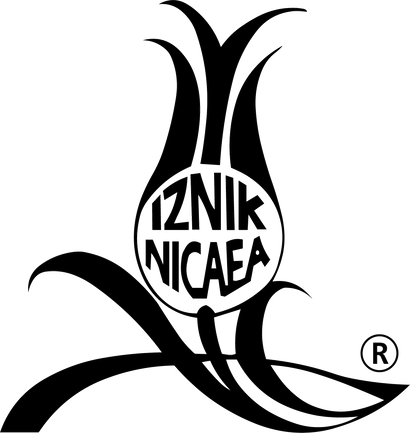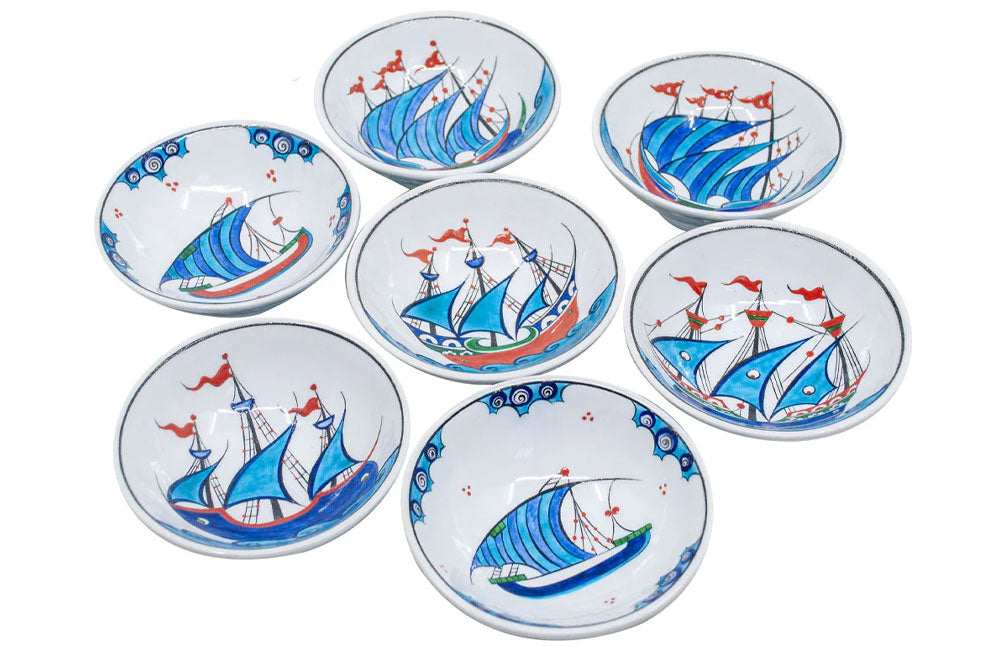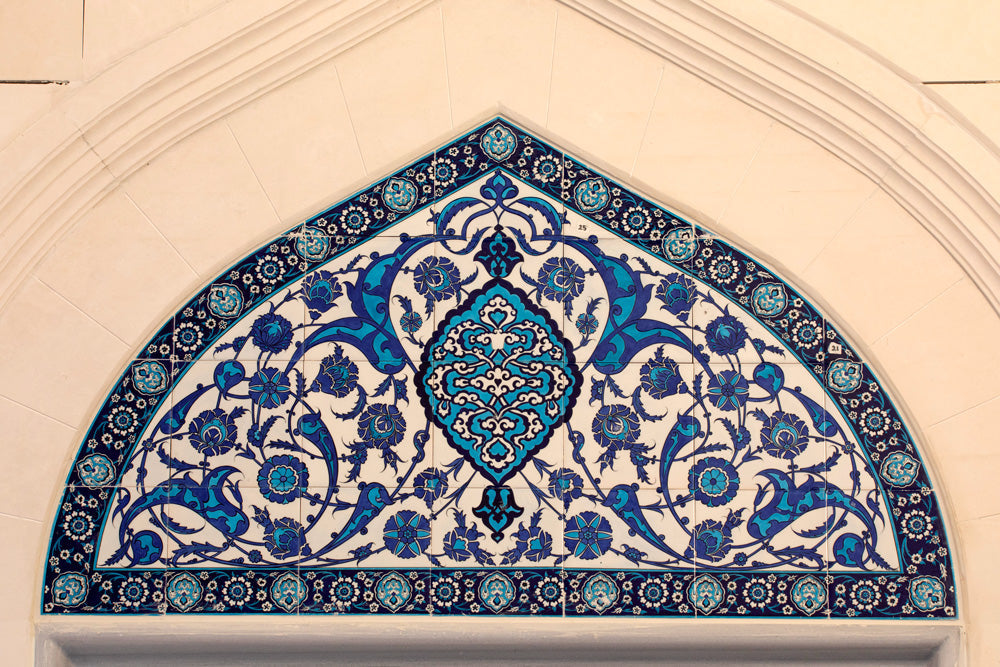Welcome to Iznik tile world
Welcome to Iznik tile world
Mehmet Gursoy: Bringing a lost art back to life
February 01, 2017 10 min read

You can see it in any major tourist area in Turkey, in small shops and large, in bazaars and neighborhood stores: row upon row of Turkish ceramics -- a dizzying array of plates, bowls, vases, pitchers, coffee cups, ashtrays, tiles -- in short, anything that can be fashioned from clay. And the name most frequently mentioned in connection with it is Kutahya, a pleasant city about an hour's drive from Eskisehir in Central Anatolia.
Armed with insufficient money and almost maxed-out credit cards, I decided to head for this mecca of pottery-lovers. My goal was to meet Mehmet Gursoy, an artist whose work I had become familiar with in Ankara, and whose pieces clearly stand far above the rest in terms of beauty and technical excellence. After perusing countless small shops crammed with a profusion of ceramics so garish that it left me wondering why I had come here, I fled to the peace and quiet of Gursoy's shop and relaxed in the cool elegance of his finely crafted work.
Gursoy is a master cinici, or maker of cini, defined by Henry Glassie in his book "Turkish Traditional Work Today" as "cognate with china" and meaning "tile" but which encompasses "all pottery painted underglaze on a composite white body, including tiles..." Gursoy creates pieces based on the white ceramics known as Iznik cini, decorated with blues, turquoise, green and red, that were produced in Iznik and Kutahya from the 15th to 17th centuries. But he doesn't just copy old pieces or make reproductions; he extracts principles from them to use in new creations, adding his own interpretation and innovations to the original compositions.
Born in Denizli in 1950, Gursoy moved to Kutahya at the age of 10. After completing his education, he was working as an elementary school teacher in a village near Kutahya, when in 1975 he first started making cini.
"At that time the art of ceramics was about to die in Kutahya. The beautiful pieces from long ago could no longer be found. I wanted those art pieces to live on, so I decided to make them myself. I went to Istanbul and visited Topkapi Palace and old mosques, such as Rustem Pasa Camii and Ibrahim Pasa Camii, in order to study the originals from the 16th century. When I looked at them, I could see that these pieces were very different from those being produced in Kutahya, and I decided to bring the old pieces back to life," he explains.
Gursoy took private lessons from Professor Muhsin Demironat, director of the Yildiz Porcelain Factory in Istanbul, and was also studying Turkish ceramics when he realized that quite significant differences existed between the cini of Iznik and all other ceramics produced in Turkey. "I felt I could make my own artistic contribution. After I returned to Kutahya, I took my brush in hand and began drawing brand-new designs, but my models were still the 16th century ceramics. My friends all said the new pieces I was creating were different from anything else in Kutahya. When they asked me to make the same kind of pieces for them, I knew I had found the right path," comments Gursoy.
"I did this until 1986, while still teaching, on a little table in my tiny house. That same year the First International Ceramics Congress was held in Kutahya, and an international competition was also staged. I wasn't very hopeful, but I thought since I was making these pieces, I would enter them in the competition, along with first-rate artists.
"There were three categories: vases, plates and tile wall panels. I worked day and night for 41 days without a break, and as the competition committee requested, I designed new compositions that had never been seen anywhere before. At the end of the competition I was delighted because I won three big prizes in the plate, vase and panel categories. I never expected that, but it was very important for me because this was an international competition.
"I felt I needed to establish a studio in order to preserve this art, so I set up my atelier, Iznik Cini, in April 1987 for this purpose. Since then I have continued this work in my atelier with my students," he says. Some people objected to his naming the workshop for a city other than Kutahya; however, he notes, the name refers to an artistic concept, a ceramic type, not a particular place.
Gursoy began to gain both national and international recognition and started to exhibit his work overseas as well as in Turkey. "I was invited to the United States, to the Museum of International Folk Art in Santa Fe, New Mexico, in 1991 and I had my first exhibit there, which attracted a lot of attention from the press. Then I exhibited at the Istanbul Fine Arts Academy in 1992. The mayor of Memphis, Tennessee, and the media attended, and they really loved my pieces. As a result my work was displayed at the 'Ottoman Sultans' exhibition in Memphis, which lasted for six months; approximately 500 pieces were sold.
"My art production reached its height in 1994, and I was invited to Germany's Dusseldorf NATO Air Base, where I attended a cultural festival and presented my pieces. I also showed at the Hamburg Ethnographic Museum, as well as in Hanover, Cologne, Bonn and again in Dusseldorf. Then I went to Salzburg, Austria, to put on an exhibition there. That was important to me, to be able to exhibit in the city where Mozart was born, because it's a city of art. My pieces were displayed to the musical accompaniment of another artist."
Gursoy fondly recalls the success and satisfaction of another show he staged in the United States. "In 1994 I was invited to Indiana University, and I exhibited at the museum there. All my pieces were sold in just 12 minutes -- this is the greatest joy in the world for an artist. I remember a man who had picked up one of my pieces and was walking around with it clutched to his chest. However, there was another person following him. When I asked what he was doing, he said, 'Maybe he'll put the piece down so I can grab it!'"
Gursoy's reputation continued to grow, and he was asked by the Turkish government to represent his country overseas. "I was unexpectedly sent to Oman by the Foreign Ministry in 1999 to participate in a festival. Even though the people of Oman do not have much in the way of fine arts, my exhibit was greatly appreciated, and they kept coming back to buy my work." He has an upcoming show in Izmir on Sept. 16, in conjunction with the Turkish-American Association (TAA), and will travel to the Netherlands in November and the United Arab Emirates next May, again at the request of the Foreign Ministry.
Gursoy has one aspiration which has not as yet been realized. "I have a very big project; my goal is to open an exhibition in Washington, D.C., at the Smithsonian Institution. I want my ultimate exhibit to be there," he confesses.
At the time of my visit, the artist was finishing up work on a huge order from the Foreign Ministry -- 450 pieces to be given as official presents by the Turkish government, both at home and at Turkey's embassies and consulates around the world. He had delayed packing the shipment up just so I could admire them.
I was awed by their pristine beauty. Plates, vases, pitchers, long-necked vessels, tiles -- all decorated in lustrous colors against a pure white background. Much to my dismay, almost everything in the shop belonged to the ministry; I comforted myself with the knowledge that I already possessed several of his pieces purchased in Ankara and that my credit cards would not suffer any major blows that day.
In addition to the wealth of generic Kutahya ceramics found in the small shops and ateliers, Kutahya is also a major porcelain center, as evidenced by the numerous large factories dotting the road into town. Gursoy surprised me with the differences between porcelain and cini. "Porcelain is functional; it can be used for food and in the kitchen, but cini is a feast for the eyes -- you hang cini on the wall and look at it, but porcelain you use. It's true you can eat off of cini, but it would be a shame, because it's made for looking at. Porcelain is fired at 1,200 degrees Celsius, but cini is fired at 900 or 1,000 degrees. Cini is fine art, but porcelain is not."
Being a collector of Bizen pottery, one of Japan's oldest types of earthenware, which is neither painted nor glazed and is fired for 14 days in wood-burning kilns, I was interested in the processes and time involved in producing Iznik cini.
"Turkish ceramics is one of the most difficult types of ceramic art. We use seven different materials found in nature, such as quartz, kaolin, chalk and sand. We mix these materials together until they have the consistency of clay. We blend them together, grinding them to get rid of any impurities -- it's a special formula. It takes 15 days for this clay to become a work of art. I throw my own pieces on a wheel in the basement of my apartment, with the exception of tiles, which require a 200-ton press that I simply can't afford. After the piece is formed it needs to dry for 15 days to get rid of all the moisture. When it's dry, it is covered with a pure white quartz-based underglaze, like the white of an eye. This white background is what makes Turkish cini distinct from other ceramics. Natural colors show up beautifully, something that was first recognized by Ottoman palace artists.
"The pieces are sent to the kiln for the first firing, which is set at 1,000 degrees Celsius, and they are fired very, very slowly -- 15 or 16 hours. After this, designs that are suitable to the form are applied, first outlined in black pencil on paper affixed to the object. Next the pattern is smeared through numerous small needle holes with carbon powder and then is filled in with colored underglaze. First cobalt, next turquoise, then green and finally red. After the motifs are painted, the pieces are covered with a clear glaze.
"At this point any mistakes are corrected, and then comes the second firing. Piece by piece, so that they don't touch, objects similar in shape are placed on the kiln shelves. They are fired again very slowly and then cooled -- again very, very slowly. If they take 14 hours to fire, they must have 14 hours to cool, because sudden cooling would be too much of a shock and would cause the pieces to crack."
What is the most distinct feature of Turkish cini? Why do people like it so much? Why are today's museums filled with it? Gursoy quizzed me, and then provided the answer himself: "Because it is one of the most important art forms in the world.
"Why is that? Because Ottoman palace artists captured the colors of precious stones under the glaze. Coral red, emerald green, turquoise, the most beautiful cobalt blue are all there. When people hold these objects, they see the colors of these precious stones, and they feel warmth and happiness. Also, the compositions have a marvelous stylization. Tulips, carnations, roses, hyacinths, lotuses and animal figures are drawn with such beautiful stylization that people feel joy when they look at them."
Another characteristic of Turkish design is that it reflects the enormity of the Ottoman Empire. "Since the empire was so big, its art was also grand. You can see this size in the compositions. If you look very carefully at them, you will be able to observe the foundation, rise, expansion and fall of the Ottoman Empire. They relate the life of the people and the nation.
"Yet another special characteristic is the triangular balance. The harmony and balance of earth, moon and sun together is what created the world. This balance is also present in the compositions of our work -- you can see it in every piece. In one, you'll see three tulips, three carnations and three roses. They are different in color, and they are separated from one another. There is balance in composition and in color.
"The Ottoman artist was influenced by repetition and routine, but mainly by nature. He discovered himself in nature. For example, he showed tulips, carnations, roses and hyacinths in profile. Ships also were very important for the Ottoman Empire. They used them successfully in war, and they were an integral part of the daily life of Istanbul; therefore, they were put into the art, appearing in a highly stylized fashion.
"There were vineyards in Iznik. For that reason, grapes are one of the fruits that were depicted in the art. Pomegranates also. There's no other fruit. There are no pears or apples, for instance. There are fish, and the rest are all flowers. They're stylized, they're not three-dimensional -- they're sliced vertically."
Early Ottoman artists would slice open tomatoes and peppers, and based on the shapes they saw within created the "rumi," or arabesque style, which combined ornamentation derived from the young shoots, leaves and stylized animal figures that the Anatolian Selcuks had used. They cut open marul (romaine lettuce) and observed its lines and created the "hatayi" style, a lush and flamboyant incorporation of serrated leaves and palmettes. "These are important things. It's an art to look at the contours in the world of nature, the contours that Allah created, and be able to transfer them to clay, stone and paper. All creatures in the world are beautiful. All things that Allah created are beautiful, because they were made with the utmost of care. Because of this, the lines of all creation are perfect, and being able to see them is the art of Turkish cini. This doesn't exist in other art forms. You see the beauty of a tulip, but you draw it as you imagine it; you take what exists and stylize it -- you don't just copy it. This is the art -- to take that flower and adapt and compose it as you imagine it to be," Gursoy notes.
Describing himself as a humanist, Gursoy explains what is important to him. "I work 16 to 17 hours a day. My focus is on my wife, my children and my art. I have a debt to mankind. I ask God to grant me a long life so I can repay my debt to people. For this reason my goal is to live to be 100.
"And I would like to do something for people. Whoever wants to learn, from whatever country they come, I am willing to devote my days and nights to teaching this art. I would like to convey my knowledge of ceramics to all people."
Visitors are always welcome at Mehmet Gursoy's atelier and shop, Iznik Cini, located on Ataturk Bulvari in Kutahya. His work is also displayed in Turkish missions overseas, in private collections and in various museums, including the Museum of Anatolian Civilizations in Ankara ,Topkapi Palace and Hagia Sophia museum shops. You can find it in Ankara at Cesni in Ertug Pasaji as well as at shops in Atakule and Karum, in Istanbul at the Arasta Bazaar, and at Gocek in Kusadasi. It is also for sale at the Smithsonian's Sackler Gallery of Asian Art in Washington, D.C.
Also in News
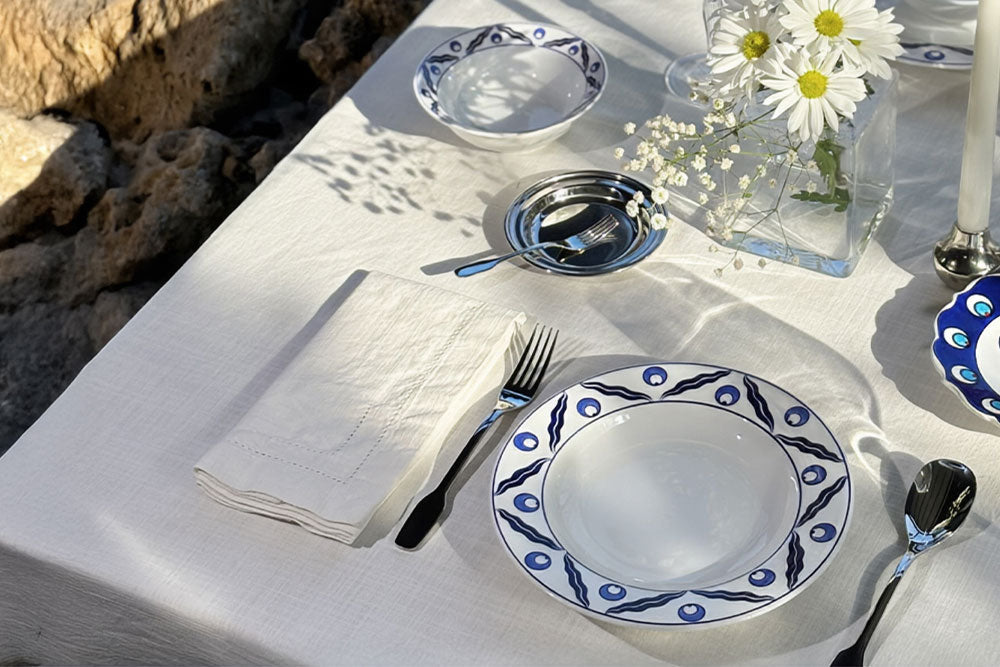
Rediscovering Timeless Beauty: Handcrafted Iznik Ceramic Dinnerware for the Modern Table
April 08, 2025 2 min read
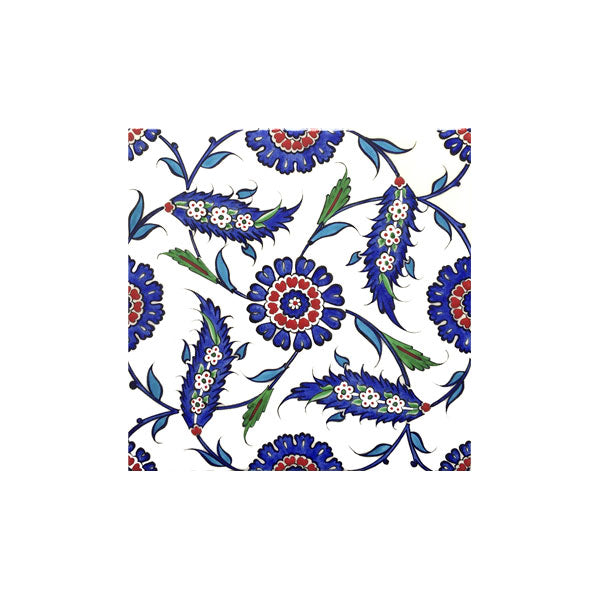
Thank you for being here!
Join us to discover the latest in Iznik tiles, enjoy special offers, and celebrate the beauty of Turkish artistry together.
